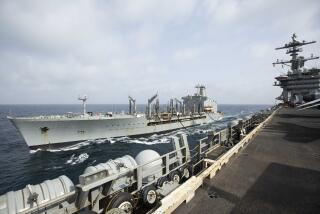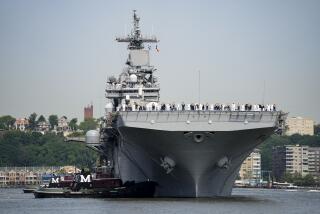SHIELDING U.S. WARSHIPS
The Silkworm and Exocet missiles in Iraq’s arsenal are thought to be particularly deadly to allied warships. With Iraq’s air force essentially out of commission, that threat has subsided, but danger remains from land-launched missiles. An even bigger threat is mines. Just this week, two U.S. warships were damaged in the Persian Gulf, including the Princeton, a Ticonderoga-class guided missile cruiser (right). Here is how a ship defends itself.
U.S SHIPS IN THE GULF WAR FRIGATES: 7
Displacement: 4,100 tons; Length: 445 feet; Crew: 206 DESTROYERS: 12
Displacement: 8,040 tons; Length: 563 feet; Crew: 330 CRUISERS: 14
Displacement: 9,407 tons; Length: 567 feet; Crew: 360 BATTLESHIPS: 2
Displacement: 57,353 tons; Length: 887 feet; Crew: 1,570 AIRCRAFT CARRIERS: 6
Displacement: 96,386 tons; Length: 1,040 feet; Crew: 6,050
PROFILES OF A MISSILE ATTACK
100 MILES: Depending on the enemy plane’s elevation and weather conditions, the ship’s radar should be able to spot it.
40-60 MILES: Traveling at Mach 2, the ship’s SM-2 missiles try to destroy incoming planes before the planes even launch their missiles. If the planes launch their missiles before being destroyed, the SM-2 also has an anti-missile capability.
8-13 MILES: Firing 20 rounds per minute, the large-caliber 5-inch guns are capable of shooting down incoming missiles.
LESS THAN 2 MILES: Extensive electronic countermeasures and chaff try to distract missile from target.
1 MILE: Firing 3,000 rounds per minute, the Vulcan Phalanx anti-missile guns are the last line of defense.
AEGIS COMMAND AND CONTROL SYSTEM
The Aegis radar system is the U.S. Navy’s most advanced detection system to counter anti-ship missiles. It allows ships to spot, track and lock on to multiple targets simultaneously. Radar systems detect incoming missiles or aircraft, then the threatening radar contacts. If desired, computers automatically control the weapons, which destroy incoming missiles. The ship’s Combat Information Center has sophisticated displays that give the officers an accurate picture of the situation.
A. Anti-ship Harpoon missiles
B. Anti-submarine torpedoes
C. Rapid-fire Phalanx guns.
D. Sea Sparrow and SM-2 anti-aircraft missiles.
E. Large-caliber 5-inch guns.
F. Despite heavy steel hulls, warships are especially vulnerable to mines. U.S. ships in the Gulf depend on U.S., British and Saudi minesweepers to keep the seas open.
ECM AND DECOYS
U.S. ships have extensive electronic countermeasures (ECM) capable of disguising and distorting radar images sent back to the enemy missile and plane. One element of ECM is to project a false electronic image (ghost) of the vessel away from the real ship. The incoming missile must then decide which is the real ship and which is the ghost image. If the enemy missile continues toward the ship, “chaff” launchers (mortars) send clouds of aluminum strips away from the ship in another attempt to confuse enemy radar.
Sources: U.S. Dept. of Defense, Jane’s Fighting Ships
More to Read
Sign up for Essential California
The most important California stories and recommendations in your inbox every morning.
You may occasionally receive promotional content from the Los Angeles Times.










